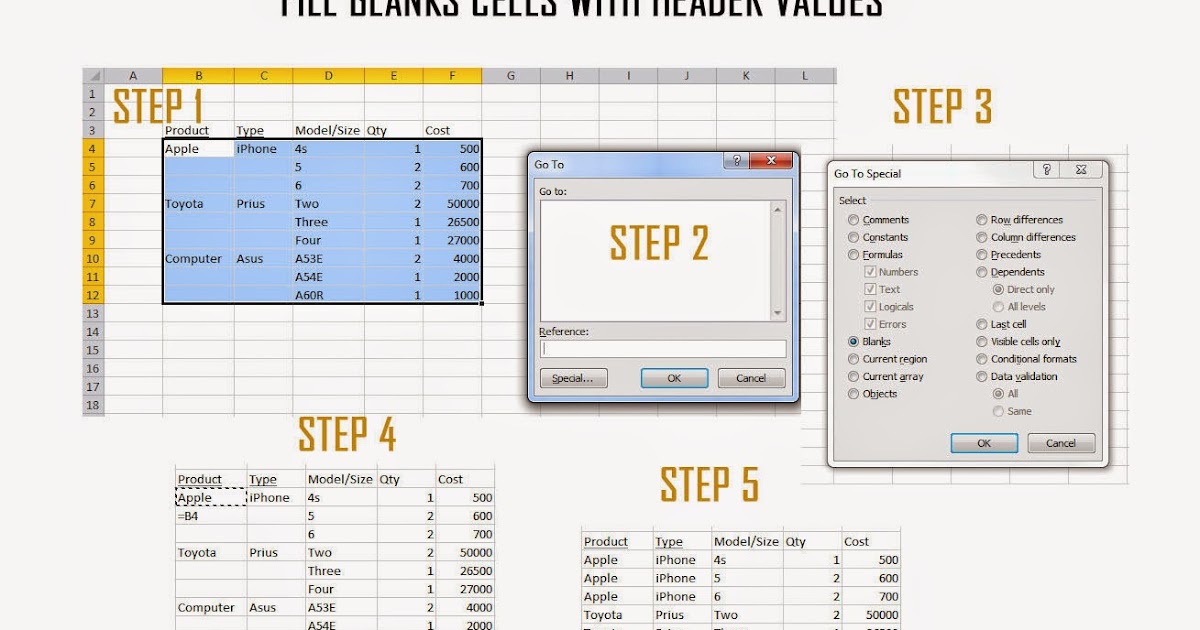5 Ways to Effortlessly Fill Empty Excel Cells

When working with data in Excel, encountering blank cells is almost inevitable. These empty cells can disrupt data analysis, skew calculations, or simply make a spreadsheet look incomplete. However, filling in these cells doesn't have to be a cumbersome task. Here are five effective methods to effortlessly fill empty cells in Excel, ensuring your data remains consistent and your spreadsheet looks professional:
1. Using Go To Special Feature
Excel’s Go To Special feature is incredibly useful for targeting specific cell types, including empty cells:
- Select the range of cells you want to work with.
- Go to the Home tab, find the Find & Select button in the Editing group, and click on Go To Special.
- In the dialog box that opens, choose Blanks and click OK. This highlights all the empty cells.
- Now, type in the value or formula you want to fill these cells with.
- Press Ctrl+Enter to fill all selected blank cells with the entered content simultaneously.
2. The Fill Down Technique
For filling a column or row with data from a known cell:
- Select the cell with the content or formula you want to copy.
- Move your cursor to the bottom-right corner of this cell until you see the cross cursor.
- Double-click this cross or drag down to the last empty cell you wish to fill.
This method efficiently replicates data in one direction without affecting other cells.
3. Using Flash Fill for Pattern Recognition
Flash Fill is Excel’s smart feature that can recognize patterns in your data:
- Start typing the pattern you want to replicate in the first cell next to your data.
- Continue typing the same pattern for at least one or two more cells.
- Once Excel detects a pattern, it will suggest auto-filling the rest. Press Enter to accept, or click the Flash Fill button if you prefer.
Flash Fill is particularly useful for formatting names, addresses, or dates without complex formulas.
4. Employing Formulas to Fill in Gaps
When you need to fill cells with dynamic content:
- Use the IF function to check if a cell is empty, like this:
=IF(A2="", B1, A2)
Here, if cell A2 is blank, it takes the value from B1; otherwise, it keeps A2's content.
- This formula can be extended to fill entire columns or rows by dragging down or across.
5. Custom Macro for Automatic Filling
For those who frequently fill empty cells or need a more sophisticated solution:
- Open the Visual Basic Editor by pressing Alt+F11.
- Insert a new module and add the following code:
- Run this macro by selecting your range, going to Developer Tab (enable if not visible), then click on Macros, and run FillEmptyCells.
This macro fills empty cells with values from the cell above it.
📝 Note: Macros should be used cautiously as they can alter your data automatically. Always backup your work before running macros.
In today's data-driven world, Excel remains an invaluable tool for analyzing, organizing, and presenting data. Filling empty cells is a fundamental task that can significantly enhance the usability and aesthetics of your spreadsheets. By mastering these five techniques, you can transform a messy dataset into a well-organized masterpiece, improving both your productivity and the professionalism of your work. Remember, each method has its strengths: Go To Special for quick selection, Fill Down for straightforward replication, Flash Fill for intelligent pattern recognition, formulas for dynamic filling, and macros for custom solutions. Integrating these tools into your workflow will streamline your data management process, making you an Excel maestro in no time.
What should I do if I want to fill cells with different data?
+You can adapt the “Employing Formulas” method by using conditional logic or additional columns to categorize data, then apply formulas or conditional formatting accordingly.
Can these methods apply to numbers and text?
+Yes, all the methods described above work with both text and numbers. Flash Fill, for instance, can fill text based on recognized patterns, while formulas can manage both text and numerical data.
Is there a way to revert changes if I make a mistake?
+Always back up your work before making changes. Use Excel’s “Undo” feature (Ctrl+Z) if you make mistakes, or you can recover previous versions from the File menu under ‘Info’ > ‘Manage Workbook’ > ‘Recover Unsaved Workbooks.’



